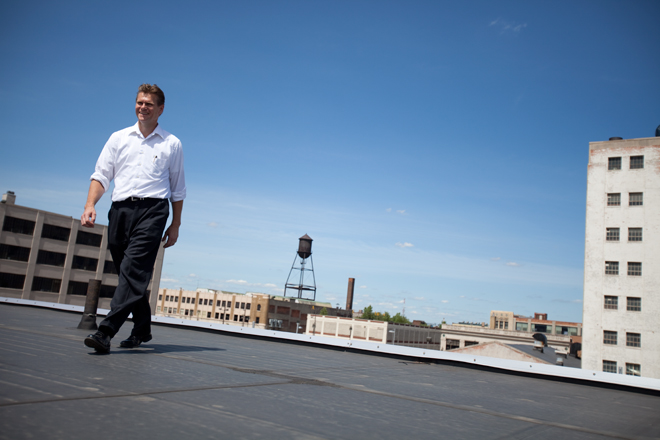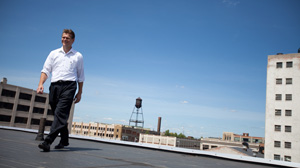BY ELENA RUE & MIKE ERLICH
At 12:55 p.m. on May 31, 2007, the last Lincoln Town Car rolled off the assembly line at Ford’s Lincoln plant in suburban Detroit. The plant opened its doors in 1957 and, at its height, employed 5,000 people.
This story is a familiar one. For the last several years, Americans have watched the auto industry collapse plant by plant and unemployment rates rise point by point.
But the Ford Wixom Assembly Plant has made plans to get back on its feet. It will use its same manufacturing expertise, but instead of motors and carburetors, production will include wind turbines and solar panels.
If it is successful, the repurposed Ford Renewable Energies Park in Wixom will become one of the largest renewable energy manufacturing parks in the country. With an initial investment of $725 million, production is scheduled to begin in 2011, and the facility is eventually expected to create 4,000 jobs.

Michigan Central Station, built in 1913, operated in Detroit until 1988. The abandoned building has become a symbol for the city’s decay. Photo by Elena Rue
Michigan Lt. Gov. John Cherry drew a direct link between manufacturing in the automotive and environmental fields.
“The automobile is the most sophisticated, widely marketed consumer product,” Cherry said.
“An auto facility, if it no longer produces components for the auto industry, is easily converted to a facility for the manufacturing for a life science product or manufacturing a component for wind energy technology. There’s a lot of synergy.” Like the Wixom plant, Detroit, too, must get back into production and recreate jobs in order to create a viable future.
In the early 20th century, Detroit dominated the auto industry. By 1998, Detroit’s Big Three – Ford, General Motors and Chrysler – held 70 percent of the U.S. auto industry market share.
At that time, Detroit’s population was roughly one million people, and the unemployment rate was 7.3 percent.
Fast forward to 2010. After going through one of the largest industry failures in our nation’s history, the Big Three have received billions of dollars in federal bailout money.
In the last decade, nearly 100,000 people have fled the city as its unemployment rate has jumped to 22.9 percent.
Now, the same manufacturing infrastructure that helped Detroit to control a booming auto industry could help bail it out from that industry’s failure.
Michigan Gov. Jennifer Granholm’s administration has pushed the federal government for support of the state’s renewed manufacturing efforts, particularly in alternative energy technologies.
The Ford Wixom Assembly Plant serves as a tangible example of this transformation.
Xtreme Power and Clairvoyant Energy, the two alternative energy companies that purchased the plant, plan to occupy half of the 320-acre plant for solar power and energy storage system manufacturing. They will leave the other half open to attract similar businesses.
This strategy relies largely on providing resources for entrepreneurs and startup companies with cutting-edge technologies.
“In the energy field, you’ve got to increase the amount of technology that’s in your manufacturing process,” Cherry said, “which gives entrepreneurs a real role.”
Granholm’s administration has focused heavily on supporting second-stage entrepreneurs who are ready to start manufacturing their products, and on research and development for emerging companies.
If these companies begin production, they can create jobs and bring people back to Michigan.
One such entrepreneur, Garth Schultz, is nearing the production phase with his company, Power Panel. His prototypical panel provides both solar and thermal energy, and he is seeking the final funding to move into production.
“I mean you’ll have the Model T kind of people coming along that will have those groundbreaking kind of technologies that make it affordable,” Schultz said. “And that’ll be the real coming of the industry.”

Garth Schultz walks on the roof of NextEnergy, the alternative energy incubator that houses his solar panels and lab space. Photo by Mike Ehrlich
Even as the people of Michigan use skills and resources from the auto industry to try to spark the economy, they are careful to learn from past mistakes.
They know that the alternative energy alone can’t replace the auto industry in Michigan. In fact, they know that no single industry can do so.
Michigan’s future lies in diversifying its economy across a variety of industries, while maintaining its engineering and manufacturing presence and advantageous natural resources.
“We were a mono-crop economy with the auto industry,” said Jacob Corvidae, green programs manager at the WARM Training Center. “The auto industry has troubles — we fall apart. And this is where the lessons of biodiversity apply to the economy. We need a more diverse economy to be functional.”

